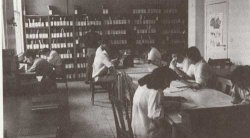

|



 Lebanon
Lebanon

|
Directory Information
|
Called Land of the Cedar in the Bible, Lebanon could also be called the land of the book. A Phoenician inscription at a tomb believed to be that of Ahiram, dated between the 13th and the 10th centuries B.C., is located atjbail, which the Greeks translated as Byblos, from the word biblio (book). Such Lebanese archaeological sites as Baalbek, Tyre, Sidon, Tripoli, and Byblos show signs of libraries during the classical period, During the monastic period, almost every monastery had a library, but they were not organized.
The best-known monastic libraries were the Holy Savior, founded in 1711 near Sidon, and the Salvatorian monastery at Khonshara, founded in 1696, both belonging to the Greek Catholic sect. A microfilming project in 1970 recorded the collections of all the monasteries; microfilms were deposited at the American University of Beirut (AUB).
Modern librarianship in Lebanon started in the 19th century with academic libraries. The Syrian Protestant College (which became the AUB established in 1866 and the French Saint Joseph College in 1881. Most of Lebanon's libraries were founded in the mid-1960s in Beirut, the capital, or its outskirts; rural areas had few services or nothing at all.
Civil war between Muslim and Christian Arabs broke out in 1975 and raged for more than a year.Many libraries were destroyed, burned, or looted. The heaviest losses were at the National Library and the Lebanese Center for Documentation and Research(CEDRE). Those remaining were indirectly affected by the loss of personnel; frozen or cut budgets; inflation; and the devaluation of the local currency.
These factors halted library services or held advances to a minimum in more than 80 percent of the existing libraries. But the war brought some positive developments. The political parties involved in the conflict setup their own cultural centers, most including libraries, to promote their ideologies. Some cultural centers published bibliographies. Book exhibitions were cornmen and frequent in large cities. Publishing continued to be active and highly productive. The Lebanese government established a Ministrv of Culture in 1991 with promotion of libraries as one of its aims.
National Library
The Lebanese National Library, also a public library but without borrowing privileges, was placed under the Ministry of National Education in 1922. It started with the personal collection of Viscount Philippe de Tarazi at the National Museum. In 1937 it moved to the Parliament building. A copyright deposit law was passed in 1941 and amended in 1959, but the Library could never enforce it. The Library's aims and objectives were never defined, and it never had a qualified librarian. No recent inventory has been taken; some of its 100,000 volumes and 2,000 rare manuscripts were burned or stolen during the civil war. A National Library did not exist, except in name, in the early 1990s.
Sources:



|